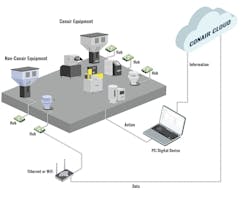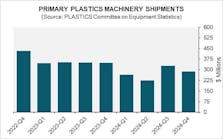Edited by Bruce Geiselman
Conair Group has noticed customers increasingly asking about smart auxiliary equipment.
“They’re asking, but not in so many words,” said Sam Rajkovich, VP of sales and marketing for the major U.S. manufacturer of auxiliary equipment including blenders, dryers, conveyors and granulators. “Instead, we’re hearing comments, concerns and questions from customers about workforce shortages and training difficulties, the loss of operational/tribal knowledge (e.g., the ‘old timers’ who really know the equipment), the need to simplify and automate processes to reduce intervention from inexperienced people, etc.”
Rajkovich provided written answers to questions submitted by Plastics Machinery & Manufacturing about smart auxiliary equipment, what it is and what the future holds.
How do you define smart auxiliary equipment?
Rajkovich: Let’s start with an analogy: Much like a smartphone does much more than just make and receive calls — a smart control does more than just accept setpoint inputs and turn a piece of equipment on and off. Ideally, smart auxiliary equipment and controls:
- Analyze feedback from sensors and make adjustments.
- Offer on-screen tutorials so that the operator doesn’t need a 10-minute refresher course with the instruction manuals before changing a setting.
- Operate on “cruise control,” responding to changing process conditions, and overcoming/avoiding potential future issues, to maintain desired outcomes.
- Communicate with other equipment, software or systems.
With that said, we believe that “smart” can be defined as several different things:
- First, smart auxiliary equipment simplifies and automates a good result, such as a drying control that totally controls and adjusts as necessary the fundamentals of drying (airflow, dewpoint, time, temperature), while also monitoring resin moisture levels to a setpoint, or delivering drying capacity when needed to ensure dry material is entering a process. Another example would be a conveying control that proofs sources and destinations, while reliably delivering material using the right speed or pump vacuum level regardless of the distance of the receiver. It also might be a feature that tallies resin usage through a process based on weigh cycles. It does the right things automatically, with little or no human intervention, except for perhaps the initial setup and setpoints.
- Second, it means a control interface/user experience across machine types that is easy and approachable for operators, that standardizes common interactions and symbols, that is easy to use even with limited training, and that offers on-screen tutorials for less-experienced operators. This approach breeds familiarity, enabling operators to act more intuitively and confidently when they are making a process control decision. Conair has been developing and pursuing this approach for years, by developing and deploying a common control/common look and feel across every family of digitally controlled equipment that we offer.
- Third, we believe smart equipment should be able to share information seamlessly so that it can be collected and used in production trending, inline or process monitoring or management, in maintenance planning, or in management decision-making. For us, that has meant marrying up a common control interface with our cloud-based SmartServices monitoring and management platform. As users will see at our many live hands-on NPE demonstrations, they can remotely utilize machine-level smart controls on dozens of pieces of auxiliary equipment or manage the same equipment collectively using the same control interface on our SmartServices platform.
What is new in smart auxiliary equipment?
Rajkovich: What’s new is that the smart equipment approach (as outlined above) is being applied to more and more product segments and the features available continue to multiply.
For example, not long ago, Conair completed the implementation of our common control and integration with our SmartServices platform across all current families of Conair products. We will continue that integration effort as we introduce new smart auxiliary equipment at NPE 2024.
Has the pandemic/labor shortage spurred interest in smart auxiliary equipment?
Rajkovich: It was certainly a contributing factor in terms of the desire to simplify and automate various functions to make up for a lack of highly skilled operating personnel. However, the desire for more capable, easy-to-use controls and better monitoring and management systems has been building steadily. Don’t forget that there’s been a drive to develop Industry 4.0, including a long-term OPC-UA effort aimed at enabling uniform data sharing across families of machinery, including plastics processing machinery. Makers of primary and auxiliary equipment must ensure that their controls have the intelligence needed to cope with that evolving requirement.
What is the future of smart auxiliary equipment?
Rajkovich: As with many situations involving the implementation of standards, you’ll see proprietary solutions first, as you are now, then a gradual drive to integrate and interoperate across companies and platforms. It won’t happen overnight, but we’ll get there.
Contact:
Conair Group, Cranberry Township, Pa., 724-584-5500, www.conairgroup.com, (NPE Booth W2113)
Bruce Geiselman | Senior Staff Reporter
Senior Staff Reporter Bruce Geiselman covers extrusion, blow molding, additive manufacturing, automation and end markets including automotive and packaging. He also writes features, including In Other Words and Problem Solved, for Plastics Machinery & Manufacturing, Plastics Recycling and The Journal of Blow Molding. He has extensive experience in daily and magazine journalism.






